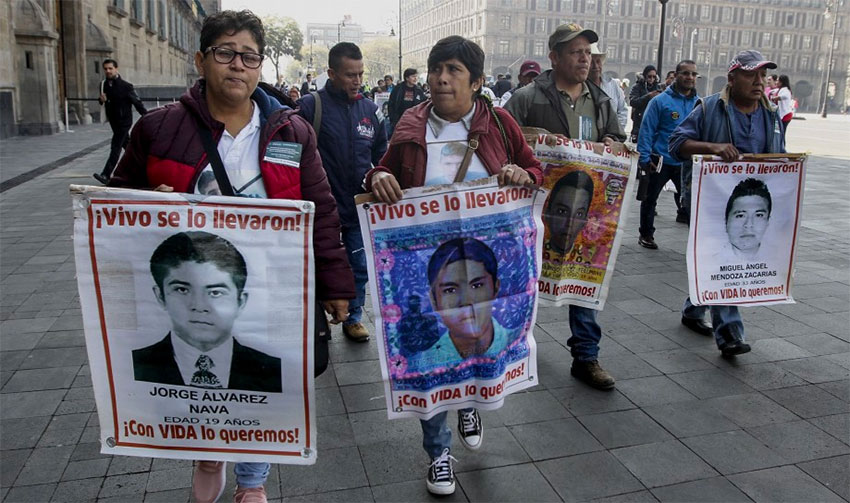Results of laboratory analyses expected within two months
by Mexico News Daily
Human remains found in Guerrero might be those of the 43 students who disappeared in September 2014, a lawyer for the victims’ parents said on Thursday.
Vidulfo Rosales said that remains found by the National Search Commission in municipalities that neighbor Iguala – the city in which the Ayotzinapa Rural Teachers College students were abducted – will be analyzed by both Mexican and foreign experts.
Some of the remains will be analyzed in Mexico and some will be sent to the Institute of Legal Medicine at the Medical University of Innsbruck, Austria, he said. Results could be ready in February or March, Rosales said.
The lawyer said that the discovery of the remains has led to the formulation of a new theory about what happened to the 43 young men who vanished on September 26, 2014. They were allegedly handed over to the Guerreros Unidos crime gang by corrupt municipal police who stopped the buses the students had commandeered to travel to a protest in Mexico City.
Rosales said the hypothesis is that the students’ bodies were not burned in the Cocula garbage dump as the previous federal government claimed in its so-called “historical truth.”
Instead, they may have been separated on September 26 or September 27 and taken to locations in the municipalities of Eduardo Neri, Huitzuco and Taxco, he said.
The lawyer also announced that experts from the Inter-American Commission on Human Rights will be allowed to continue its investigation into the case.
The previous government refused to renew the mandate of the Interdisciplinary Group of Independent Experts(GIEI) in 2016. Based on forensic analysis, the group dismissed the possibility that the students’ bodies were burned at the Cocula dump by members of the Guerreros Unidos gang, who allegedly mistook the young men for rival gangsters.
The GIEI said that its final hypothesis was that the students may have unwittingly commandeered a bus loaded with heroin that was bound for the United States.
Just two days after he took office on December 1, 2018, President López Obrador signed a decree to create a super commission to conduct a new investigation into the students’ disappearance.
However, it failed to make any significant progress in 2019 and more than 50 people arrested in connection with the case, including more than 20 municipal police, were released from prison.
Parents of the students said in November that they were giving López Obrador two months to produce results or they would increase the intensity of their protests.
Another meeting between the president and parents is scheduled for March 9 by which time it may be known whether the recently-discovered remains are those of the missing students or not.
Source: El Financiero (sp), AFP (en).
New data reveals that 61,000 people have disappeared, 50% more than reported
A year ago the government said 40,000 people were missing
There are more than 61,000 missing persons in Mexico, the federal government said on Monday, a figure significantly higher than that previously reported.
The official number of missing persons is 61,637, the chief of the National Search Commission told a press conference.
“These are data of horror that have a lot of stories of pain behind them, both of families in Mexico and of migrants,” Karla Quintana, head of Mexico’s National Search Commission said.
The figure is 50 percent higher than the 40,180 persons reported as missing in January 2019 by former search commission chief Roberto Cabrera.
Quintana said the sharp increase is due to updated and carefully revised information from state-based Attorney General’s Offices. She explained that 60,053 of the missing persons disappeared between 2006, the year former president Felipe Calderón launched the war against drug cartels, and 2019.
The other disappearances occurred in previous years dating back to 1964, Quintana said.
The search commission chief said the highest number of disappearances have occurred in Tamaulipas, Jalisco, México state, Chihuahua, Nuevo León, Sinaloa, Coahuila, Puebla, Guerrero and Veracruz.
Just under three-quarters of the missing persons are men and just over one-quarter are women.
Almost a third of the total number of missing persons – 19,108 – disappeared between 2016 and 2018, the final three years of the Enrique Peña Nieto government.
In 2019, the first full year of the government led by President López Obrador, 9,164 people were reported as missing of whom 5,184 have not been located, said human rights undersecretary Alejandro Encinas. Among the number of people who disappeared last year and still haven’t been found are 1,177 women, he said.
Encinas also said that 1,124 bodies have been found in 873 hidden graves since López Obrador took office in December 2018.
Of that number, 395 have been identified and 243 have been returned to the victims’ families, he said, adding that the highest number of hidden graves have been uncovered in Sinaloa, Colima, Veracruz, Sonora and Jalisco.
The official said that between December 1, 2018 and December 31, 2019, authorities have carried out searches for hidden graves at 519 different locations across practically all of Mexico’s 32 federal entities. In February last year, Encinas described the country as a whole as an “enormous hidden grave.”
He said on Monday that the federal government will extend an invitation to the United Nations Committee on Enforced Disappearances to have its members visit Mexico this year.
The government was criticized last month for failing to keep its promise to allow the committee to visit the country and thus open up Mexico’s investigative processes to international scrutiny.
Source: El Universal (sp), El Financiero (sp).



